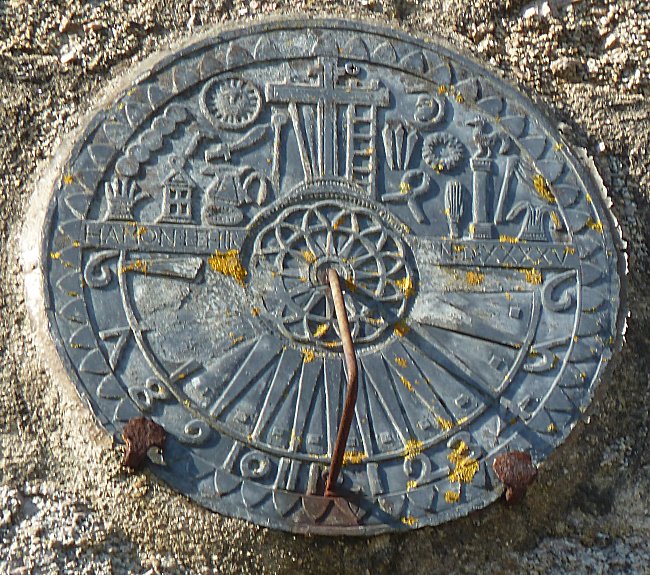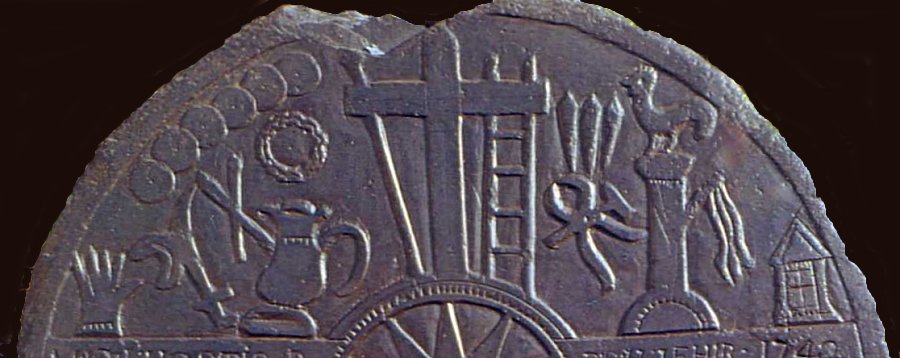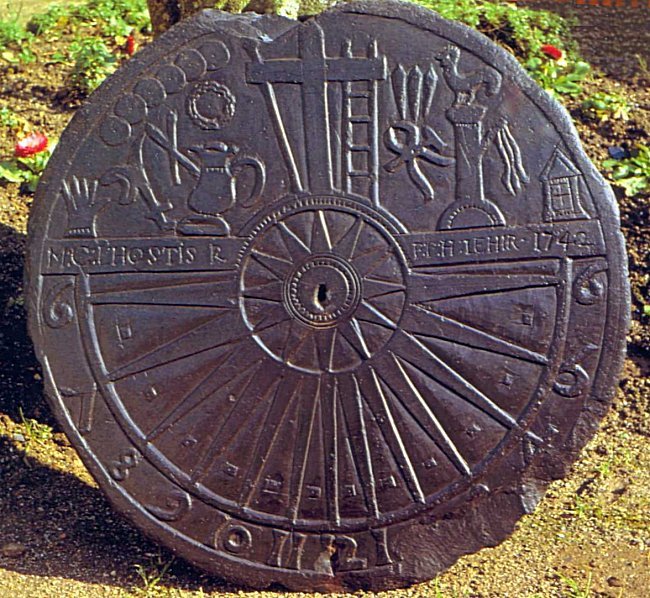This sundial, which was fixed on the south gable of the transept of the old Saint-Gouescat church in Tréouergat, is no longer visible today. The dial has been dismantled at the beginning of the XXth century when the old church was demolished to make way for the present building. It was then waiting to be fixed on the new church. But this was no longer useful because a clock was installed during the construction of the bell tower in 1925. The sundial, abandoned and obsolete, continued to wait... until its disappearance was noticed.
Since then, it has not been found.
It was a vertical south-facing dial1 of the 18th century, engraved on a circular brown slate plate.
The first image shows that the stone had been chipped, probably when it was removed from the fixing pitons. This dial was quite similar to that of Lanrivoaré, below, which is the work of the same engraver Hamon Le Hir.

The sundial of Lanrivoaré
The shadow of an inclined metallic style, parallel to the axis of rotation of the Earth, moved on the lower semicircle. We can guess on the first photo the fixing holes of this rod.
The hours from 6 to 12 were worn in the left quarter while those from 1 to 6 appeared on the right. The hour lines were in relief.
The ornamentation:
The central band bore the name of the then rector, C. L'Hostis, and that of the dial maker Hamon Le Hir as well as the date of manufacture of his work, 1742 :

M(Messire):C:l'HOSTIS R(Recteur) F(Fait):P(Par):H(Hamon):LEHIR-1742
Above the central rose window, the craftsman had carefully engraved various elements illustrating the Passion of Christ2 :

In the left part, the hand of the soldier who slapped Christ, six denarii out of the thirty who would have paid Judas, the tray stretched out to Pons Pilate with the pot containing water for his hands to wash, two crossed spears, the sword of Saint Peter who wanted to defend Christ at his arrest and the ear of the high priest Malchus that he involuntarily cut, the crown of thorns, the spear planted in the sponge soaked in vinegar. Then, to the right of the cross, the ladder of the Descent of the Cross, the 3 nails, the hammer and the pincers, the whip of the flogging, the column to which Jesus was attached to receive the forty blows, the cock of the Denial of Peter, and the lantern of the guards who arrested Christ in the garden of the olive trees.
The dial of Tréouergat, like many others of same time, was intended to associate images of faith with the essential public function of giving solar time. It was not until the following century and the invention of the railway that, gradually, the solar hour was replaced everywhere by the imposed legal hour 3.

CALLING USERS:
This sundial witch disappeared several years ago must still exist. Perhaps does it decorates today a house or a manor? It could also be in an attic or an antique store ?
|
-1-
A dial is called 'meridional' when it is a vertical South-facing one.
-2-
For the meaning of religious emblems, read on the Internet
Yves-Pascal Castel's study
-3-
See more detailed explanations on the correspondence between solar time and legal time on our page describing the sundials.
Documentation provided by Pierre Labat-Ségalen, co-author of the book:





